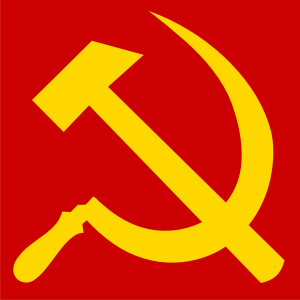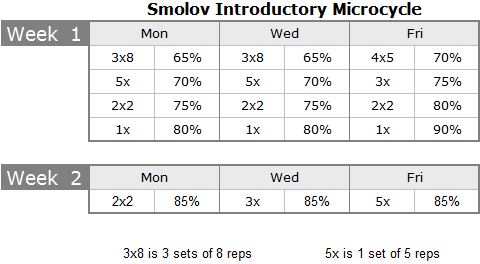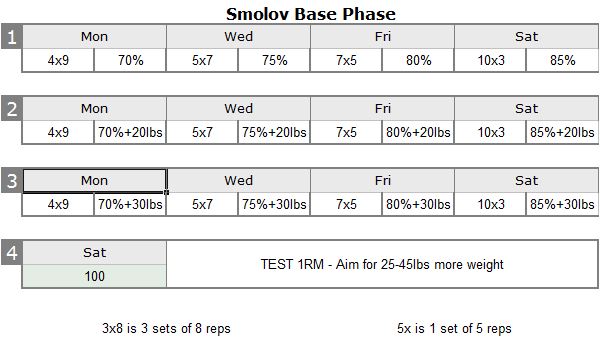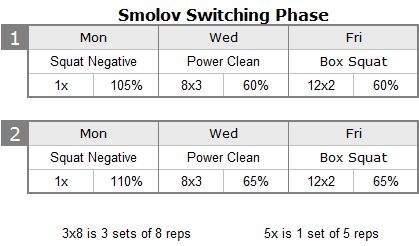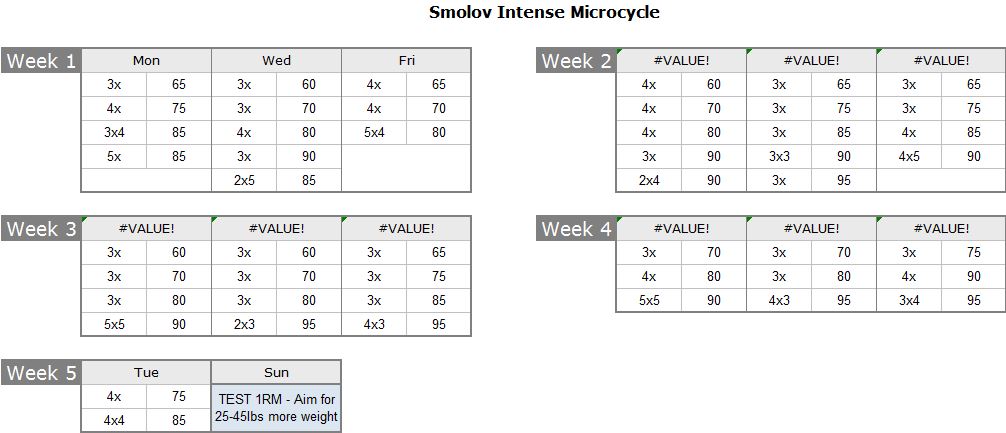Smolov is every masochistic lifters favorite program. The program is often advertised as capable of putting 100lbs on your squat in only thirteen weeks. The only thing that exceeds these lofty claims is the actual severity and brutality of the program itself. I don’t think it is an exaggeration to say that more lifters are forced to quit Smolov than any other single popularly available program out there.
In the rest of this review, we’re going to take a look at the elements of the program that allow for such potentially tremendous gains while simultaneously addressing why this program defeats so many lifters who attempt to conquer it.
We’ll also briefly look at the popular modification of the original Smolov Squat Routine: Smolov Junior for Bench.
If you’d rather watch than read:
Smolov: Background, History, Context
Smolov, as you may have guessed from the name, has Russian origins. It was, in fact, Pavel Tsautsoline who first brought the program to mainstream powerlifting attention in a 2001 PLUSA Magazine article. While Pavel may have been the messenger, distinguished Russian Master of Sport Sergey Smolov was the original composer of the program.
This program is intended to be run strictly as a shock cycle. In other words, this is not a program that you run multiple times a year. This is not a program that you do for any reason other than completely overloading the body for a given, specific time. In fact, when you run Smolov, you are not to do any deadlifting whatsoever. You are not to do Smolov while in a caloric deficit. If you ignore any of the above warnings and disclaimers, your chances of injury, which are already well above zero, only increase.
This is honestly not a program you decide to “give a shot”. Unless you have a very specific reason to NEED massive squat improvements in a short time, you shouldn’t even consider using this program. It isn’t appropriate for any other purpose. It is not intended for any other purpose. Smolov was designed to produce massive short term gains on the squat. That is the whole point.
Smolov: The Actual Program
First of all, if you want to see the Smolov program in its entirety from the get go, download the Smolov Spreadsheet.
Smolov can roughly be broken into five mesocycles:
1) “Introductory” Phase – Preparatory Block
2) “Base” Phase – Accumulation Block
3) “Switching” Phase –Transition Block
4) “Intense” Phase – Transmutation Block
5) “Peak” Phase – Realization Block / Meet Peak
Smolov Introductory Cycle
Let’s take a look at the introductory phase.
As you can see, the introductory phase features thrice weekly squatting for two weeks. You’re going to be working up to a single at 90% of your best squat in Week One. In Week Two, you’ll be working up to a set of 5 at ~85% of your best squat. These two weeks are simply in place to allow your body to adapt to the frequency and workloads that you’ll experience in the “Base” Phase. Many people skip the introductory microcycle, but, if you’re a first time Smolov user, I highly recommend against this approach. Do the introductory Cycle.
Smolov Base MesoCycle
Following the introductory phase, you’ll move into the high volume insanity that is the “base mesocycle”.
On the Base Phase, you’re going to be squatting four times per week. That’s right: four times per week. Not only are you going to be squatting four times per week, but each session is going to be more than 30 working reps as well. Hell, at the end of each week, you’re going to do ten triples at 85%!
And it just gets harder and harder. In Week Two, you’re expected to add 20lbs to the work sets you did in Week One. In Week Three, you add ANOTHER 10lbs on top of what you added in Week Two. So, by the last workout of the last week, you’re doing 10 triples at 85% + 30lbs. Is it any wonder that this program results in amazing progression for those who can survive it?
Smolov Junior for Bench Press
Just as a brief note, a lot of people were wondering about “Smolov Junior”. Smolov Junior is just the base mesocycle from the Smolov Squat Routine with a small adjustment. Take a look.
The only differences here are that instead of doing four sets of nine on Monday, you’re doing six sets of six. Instead of doing five sets of seven on Wednesday, you do seven sets of five. And instead of doing seven sets of five on Friday, you’re doing eight sets of four. The volume is maintained, but the reps per set are reduced. This actually makes the program easier by reducing the cumulative difficulty of each set early in the week.. It also tends to make a bit more specific to powerlifting because the lower reps allow you to maintain proper technique more easily.
People use this program for the bench press, but the reality is that this is just the base mesocycle from the Smolov Squat Routine with a few slight adjustments. There is nothing really that unique about Smolov Junior.
Smolov Switching Phase
The switching phase is essentially a transition block. It serves as a deload and a change of pace.
The switching phase focuses on “Dynamic Effort” work and other alternative training means. However, the focus here is less on whether or not the athlete actually gets faster and is more on the contrast in loading between the brutality of the base mesocycle and the loads used for speed work. Speed work allows lifters to produce medium to medium-high levels of force despite using relatively light weights. This prevents detraining while allowing for serious recovery. And after the four week Base Phase, you need some serious recovery.
Smolov Intense Phase
The intense cycle was actually designed by I.M. Feduleyev who is renowned powerlifting and weightlifting coach from Moscow. After the ground work that is laid by the Base Phase, the Intense Phase helps you transmute the gains into maximal strength.
It should be obvious that this is an absolutely brutal mesocycle. While you’re “only” squatting three days per week, the intensity is outrageous. In Week One, you perform 54 lifts over 80%. In Week Two, you perform 54 lifts over 80% as well, but 43 of those lifts are above 90%! In Week Three, you “only” perform 47 lifts over 80%, but you do 18 lifts over 95%. Week four is most insane of all featuring 55 lifts over 80%, 48 lifts over 90%, and 24 lifts over 95%. Needless to say, if you survive, you’re going to be ready and primed for a big time PR.
Planning
The last phase of Smolov is the meet taper which is listed above as Week 5 of the intense phase.
As you can see, Smolov is brutal right to the very bitter end. Only in the very last week of the program do you truly rest and reduce workload. Even then, the “peaking” week on Smolov is more intense than what you do on regular weeks during most American programs!
Periodization
Smolov uses a fairly complex periodization model. Let’s break it down.
The introductory microcycle is a fairly neutral programmatic addition that serves primarily just to condition the athlete to “real” phases of Smolov. The purpose here is just to introduce, or reintroduce, the athlete to higher frequencies and workloads. This is a classic preparatory block.
The base mesocycle, by virtue of the rep ranges used, is primarily aimed at hypertrophy and overall work capacity. Though there is one workout per week using triples at 85%, the rest of the week employs reps in the 70-80% range even going as high as nine reps. The intensity zones, as well as the rep ranges used, make this part of the program most conducive to mass gains. Additionally, the higher rep ranges jack up the volume to insane levels. As I’ve said earlier, this lays the foundation for the intense phase later in the program. If you can complete the Base phase, you’ll have some extra muscle, and a built up tolerance for volume, that will allow you to produce tremendous gains during the intense phase and still come out alive.
The switching phase is a classic transition block, but, in terms of periodization, it is also a block that emphasizes speed-strength. The primary goal of this period is to recover and prepare for the intense phase, but the speed-strength portion does help maintain the central nervous system adaptations as you head into the next period.
Finally, the intense phase is clearly a maximal strength period. The work over 90% is frankly just insane. This is part of the program that brings everything together to culminate in a massive one rep max PR.
Of course, the last week of the program, the peaking phase, allows you to display the gains you’ve made through the rest of the program by allowing for some much needed recovery post intensity phase.
Programming
Smolov uses a form of block programming.
As mentioned earlier, the first two weeks of the program are really conditioning weeks that set you up to handle the massive loads during the base mesocycle. The base mesocycle itself is best thought of as a volume/accumulation block.
The switching phase is a transition block which primarily facilitates recovery through deloading, but also contributes to the overall training effect of the program because of the unique speed-strength qualities that are trained during this period.
Finally, you transmute and realize all of the gains you’ve made during the intense phase and proceeding meet taper. The volume is reduced significantly, at least relative to the base mesocycle, and the intensity is cranked incredibly high. Instead of zero work above 90%, more than half of your work sets go above 90%!
As you can see, Smolov holds fairly true to the block programming model which is appropriate for the advanced athletes this program is designed for.
Specificity
The interesting thing about Smolov is that it is not actually a powerlifting program. Smolov is a squat routine. As such, on this program, you are actually not supposed to do any deadlifting whatsoever. For many of you out there who are unaccustomed to high volume programs, you’ll also probably need to reduce your overall upperbody work as well to accommodate just how demanding this program is.
As such, Smolov does lack specificity to the sport of powerlifting. This is NOT a program that you’re going to run to maximize your total. This is a program to run if you want to maximize your squat to the detriment of everything else.
The only powerlifters who should even consider a program like Smolov are those who have a horribly lagging squat that doesn’t seem to respond to anything. In such a case, a shock cycle such as Smolov might be appropriate to jump start their progress again. Otherwise though, running Smolov, while great for the squat, is going to hurt your other two lifts. Unless you feel you need a period of focus on the squat, why would you run Smolov if your goal was to post the best total possible?
As we discussed in the Sheiko review, the program also suffers from the problem of diminishing marginal returns. Smolov calls for zero movement variation. You just squat over and over again. Each additional squat session provides a diminished return on your training/recovery investment. If you got 100% return on the first session, you might get 90% on the second, 75% on the third, and 50% on the fourth.
It might be possible to get even better results with more squatting movement varieties because you often get a larger return on “new” stimulus that the body isn’t accommodated to. So, even though something like front squats are not as specific as back squats, and you’ll never get 100% carryover to your back squat, you might get more carryover from improving your front squat than you do from adding a third or fourth back squat session. Just to use the numbers above, say you get 60% carryover from improving your front squat to your back squat. We can see that, if you’re smart and efficient, you’d add the second and third back squat sessions before adding a front squat session, but you would NOT add that fourth back squat session before you added a front squat session. This is the concept of diminishing marginal returns at work and it also how you go about solving the problem.
Overload
Smolov uses progressive overload. The weight on the base mesocycle is increased every single week. During the intense phase, the %s are cranked up every single week. Each week the lifter handles heavier loads for more reps and sets. Ergo, Smolov employs basic progressive overload.
Fatigue Management
The entire idea beyond Smolov is that it should act as a shock cycle. In other words, this program is literally designed to cause you to overreach and flirt with overtraining. You’re supposed to get your butt kicked. The base mesocycle is supposed to be so brutal that it FORCES your body to do something drastic.
Smolov manages the immense fatigue it creates in two ways: a) not allowing any deadlifting or other lowerbody activity during the program and b) through the implementation of block programming. If you recall, after the base mesocycle, you’re given two weeks to recover during the switching phase. After the intense cycle, you get a peaking week to demonstrate your new gains.
Overall though, many people just can’t handle Smolov. I’ve never seen a program that produces higher burnout rate (% of people who quit) and higher incidence of injury than Smolov. Unless you just want to prove something to yourself about your toughness, there is no reason to do Smolov. Almost no one on the planet “needs” this kind of volume to make progress.
Remember, there is an optimal-dose response relationship between volume and training effect.
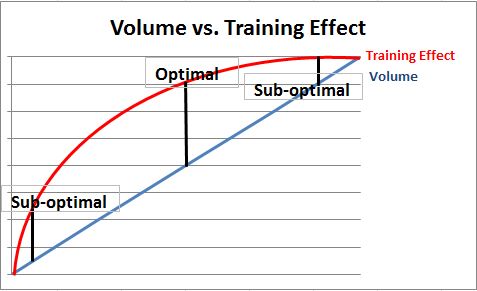
Smolov falls very, very close to the point where the volume curve actually surpasses the training effect curve. Just to give you an example, Starting Strength is famous for producing 5lbs PRs after doing three sets of 5. So, you’re getting about 1lbs of PR per five reps. Even if you get the 100lbs claimed on Smolov, you will have done approximately 900 working reps to get that gain. In other words, the efficiency is about half that of a basic program like Starting Strength. And that is only if you realize a 100lbs gain! Not many people get that much.
It isn’t necessary nor is it optimal to do a routine like this. Most people lose a portion of their gains after Smolov. Why? Well, again, what do you have to do to get further progress once your body adapts to high volume? Super high volume. Smolov is already super high volume! What program would you go to next? Almost anything you choose is going to reduce the volume so greatly that detraining is the only natural course of action for your body to take.
In my opinion, most people who do Smolov are being short-sighted and outright greedy. They’re looking for a quick way to make a huge improvement. They like the idea of spending 3 months, no matter how hard they are, to add 100lbs to their squat more than the idea of spending two years doing that. However, in the long run, 99% of these people would be better off taking the two year approach.
Individual Differences
Smolov is a percentage based, shock cycle. In many ways, incorporating individual differences is not even appropriate on a program like this. Why? Because if you tried to autoregulate the training effect of a program like Smolov, you’d just end up doing a fraction of the overall original volume.
That said, there are ways to program shock cycles that DO incorporate autoregulation and individualization. Smolov doesn’t do any of that. It is understandable why it doesn’t, but it doesn’t nonetheless.
Any advanced athlete who considers this program puts themselves in a precarious position. They basically just have to hope they’re one of the people who can survive the program. Some people just can’t. They usually quit or, worse, they get hurt.
Smolov doesn’t address individual differences at all.
Final Thoughts
Smolov is an absolutely iconic program at this point. Many people believe you should do it at least once just to prove your manhood if nothing else. While I can certainly see the appeal of trying to survive such a monstrous, brutal program, I do not believe that doing so is optimal for powerlifting progress.
First of all, this program is wholly inappropriate for beginners and intermediate athletes. There is just no way that any of you guys need to be flirting with the idea of doing a shock training cycle. You should be able to make fantastic progress on simplistic programs that give you a much better return on your training investment.
Now for advanced athletes, you have to weigh the benefits and risks of this program. You aren’t going to do any deadlifting. You’re probably going to have to reduce your overall bench volume. Likewise, you’ll probably lose much of the squat gain when you transition back to more sustainable levels of volume. You’re also very likely to quit the cycle or get hurt. Nothing about Smolov is very appropriate for long term progress.
So why even consider it? Well, I think the one time I might consider Smolov is if I was knocking on the door of a squat record. At that point, some specialization might be worth it. The athlete would just have to accept that this total was being put on hold to pursue the individual squat record. Even if you don’t keep the gains, it doesn’t matter. If you set the record, your name goes in the books until someone can erase you. Having a chance at history is probably worth it.
What about for everyone else? Honestly, do yourself a favor and commit to long term, consistent progress. Stop looking for the next magic bullet program that will allow X amount of pounds in 8-12 weeks or whatever is. Start thinking about what program you can run that will consistently give you 50-100lbs on your total every single year for ten years.
You want to know the truth? The truth is that that is exactly what the best lifters do. They commit to a long term strategy and they execute simple boring little things for years and years until they achieve mastery of the fundamentals.
Consistency isn’t sexy like Smolov is, but it is the foundation of real success in powerlifting or really any endeavor you decide to partake in.
I can’t make this more clear: I don’t recommend that you do Smolov unless you’re chasing a squat record that you have a realistic chance to break. In virtually every other case, as powerlifters interested in maximizing our total, the program is not worth the risks nor is it an intelligent way to make long term progress.
Moving Forward
After multiple review requests, I’ve decided that the next program we’re going to analyze is Paul Carter’s Base Building. I’ve actually never seen this program before so I am quite excited to dig in and see what it is all about. If you’re a fan of Paul Carter, you’ll definitely want to make sure you check this one out.
Did You Enjoy The ProgrammingToWin Series?
If so, you’ll absolutely love our eBook ProgrammingToWin! The book contains over 100 pages of content, discusses each scientific principle of programming in-depth, and provides six different full programs for novice and intermediate lifters. Get your copy now!
Like this Article? Subscribe to our Newsletter!
If you liked this articled, and you want instant updates whenever we put out new content, including exclusive subscriber articles and videos, sign up to our Newsletter!
Questions? Comments?
For all business and personal coaching services related inqueries, please contact me:
Table of Contents
Powerlifting Programs I: Scientific Principles of Powerlifting Programming
Powerlifting Programs II: Critical Training Variables
Powerlifting Programs III: Training Organization
Powerlifting Programs IV: Starting Strength
Powerlifting Programs V: StrongLifts 5×5
Powerlifting Programs VI: Jason Blaha’s 5×5 Novice Routine
Powerlifting Programs VII: Jonnie Candito’s Linear Program
Powerlifting Programs VIII: Sheiko’s Novice Routine
Powerlifting Programs IX: GreySkull Linear Progression
Powerlifting Programs X: The PowerliftingToWin Novice Program
Powerlifting Programs XI: Madcow’s 5×5
Powerlifting Programs XII: The Texas Method
Powerlifting Programs XIII: 5/3/1 and Beyond 5/3/1
Powerlifting Programs XIV: The Cube Method
Powerlifting Programs XV: The Juggernaut Method
Powerlifting Programs XVI: Westside Barbell Method
Powerlifting Programs XVII: Sheiko Routines
Powerlifting Programs XVIII: Smolov and Smolov Junior
Powerlifting Programs XIX: Paul Carter’s Base Building
Powerlifting Programs XX: The Lilliebridge Method
Powerlifting Programs XXI: Jonnie Candito’s 6 Week Strength Program
Powerlifting Programs XXII: The Bulgarian Method for Powerlifting
Powerlifting Programs XXIII: Brian Carroll’s 10/20/Life
Powerlifting Programs XXIV: Destroy the Opposition by Jamie Lewis
Powerlifting Programs XXV: The Coan/Philippi Deadlift Routine
Powerlifting Programs XXVI: Korte’s 3×3
Powerlifting Programs XXVII: RTS Generalized Intermediate Program
